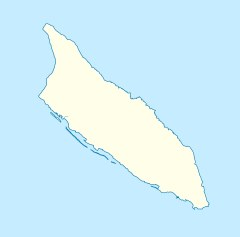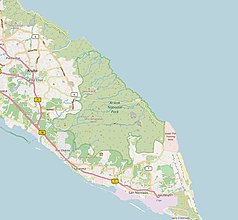Arikok National Park
| Arikok National Park | ||
|---|---|---|
| Arikokheuvel and Jamanotaheuvel in the park | ||
|
|
||
| Location: | Aruba | |
| Next city: | Santa Cruz | |
| Surface: | approx. 3400 ha | |
| Founding: | 2000 | |
| National park map | ||
The Arikok National Park (national language Papiamento : Parke Nacional Arikok ) is a nature reserve on the island of Aruba in the southern Caribbean .
history
The national park was officially approved by the Aruba government in 2000, although the plans had existed since the 1960s. In 2003, a national park foundation ( Fundacion Parke Nacional Arikok ) was established, which is responsible for the construction and maintenance of the infrastructure with around 7.1 million euros from the European Development Fund . The aim is to ensure the conservation, management and protection of flora, fauna and culture as well as the preservation of the cultural heritage within the park.
The tasks of the national park administration are:
- Carrying out scientific research and monitoring of the bat population and of the subspecies of the shower rattlesnake ( Crotalus durissus unicolor ) endemic to Aruba . The snakes have a mortality rate of 10% to 40%. They are often killed by people or run over by cars. Furthermore, illegal removals from the wild for the terrarium trade are regularly carried out. Other threats are donkeys and goats, which often trample on snakes because they perceive them to be dangerous. There are plans to remove the wild goats from the park area in order to provide better protection for the snakes.
- Afforestation of various traditional plant cultures in the park, such as the Divi-Divi trees , cacti and aloe plants . The pods of the Divi-Divi tree contain tannins , vegetable tannins. These used to be shipped to tanneries in the Netherlands. In Masiduri, visitors can also visit an exhibition on the aloe, a medicinal plant; this was one of the most important export products from Aruba in the early 20th century.
- The restoration of the traditional Cunucu-Arikok houses. Two of these mud houses have already been rebuilt near the Prins plantation. The houses were made of adobe , a mixture of clay and straw.
- The organization of various activities such as the junior ranger camp, film evenings, beach cleanings and cultural festivals such as the “Bocatage”.
- Working with other conservation organizations like the Aruba Birdlife Conservation.
description
The park in the northeast of the island is about 34 km², which corresponds to about 18% of the island's area. The park's rugged hills consist mainly of volcanic lava with quartz diorite and batholithic tonalite rocks, as well as limestone rocks made of petrified corals . The 188 m Jamanotaheuvel (in German "Jamanotahügel") high and the 176 m high Arikokheuvel ("Arikokhügel"), after which the park is named, are the two highest elevations in Aruba. On the coast of the national park there are a number of small bays that are locally called "Bocas". Boca Prins and Dos Playa are the most famous and are surrounded by white beaches and dunes. The park is home to a large number of historical sites, such as drawings by the Caquetío Indians on the rocks of Cunucu Arikok and in the Guadirikiri grotto. The rock carving of the Masiduri bird of the Caquetío Indians can be found in the logo of the park administration. Another grotto in the park that is worth seeing is the Fontein Grot .
Old plantation buildings in the park bear witness to the area's agricultural past and the days of Aruba's gold mining .
Visitor center
The single-storey central visitor complex with an area of around 800 m² was built with sustainable materials such as South American hardwood. It has exhibition rooms, a cinema and TV room, toilet facilities and ranger offices. A water basin below the visitor center provides the building with self-sufficient cooling by means of solar panels on the roof.
Web links
- Homepage Parke Nacional Arikok on arubanationalpark.org
Individual evidence
- ↑ Crotalus unicolor Aruba Island Rattlesnake. In: animaldiversity.org. Animal Diversity Web, accessed November 14, 2019 .




